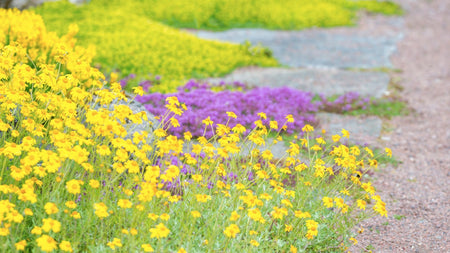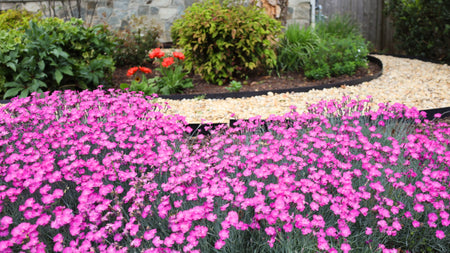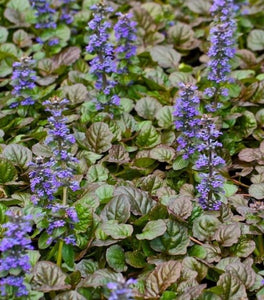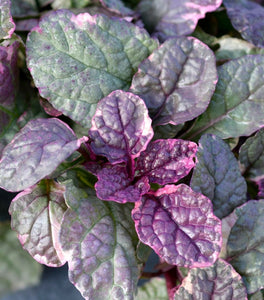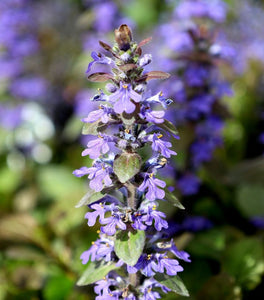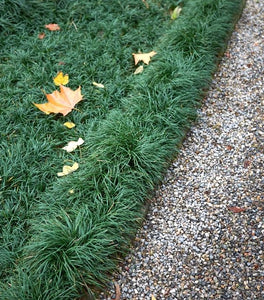
Images Depict Mature Plants
Sweet Woodruff Plants
Sweet Woodruff (Galium odoratum) is a charming, low-growing perennial groundcover prized for its delicate white star-shaped flowers and fragrant foliage. Blooming in late spring, it forms a lush carpet of whorled, lance-shaped leaves topped with clusters of dainty blooms that attract pollinators and brighten shaded areas. The soft, green foliage releases a sweet hay-like scent—especially when dried—making it a favorite in herbal gardens and for use in natural potpourris and sachets.
Ideal for shady spots, Sweet Woodruff thrives in moist, well-drained soil and is perfect for underplanting beneath trees, along woodland paths, or in shaded borders. It spreads gradually by rhizomes to create a dense, weed-suppressing mat that helps with erosion control and adds texture and fragrance to shaded garden areas. This deer-resistant and low-maintenance perennial pairs beautifully with hostas, ferns, and other shade-loving plants, bringing a woodland charm to garden beds and naturalized plantings.
With its combination of ornamental appeal, herbal use, and adaptability, Sweet Woodruff is an excellent choice for gardeners seeking a fragrant, ground-hugging plant that thrives in the shade. Whether you're filling in a shady corner or creating a whimsical woodland garden, Galium odoratum offers both aesthetic and functional benefits, making it a reliable and attractive groundcover for cool, sheltered garden spaces.
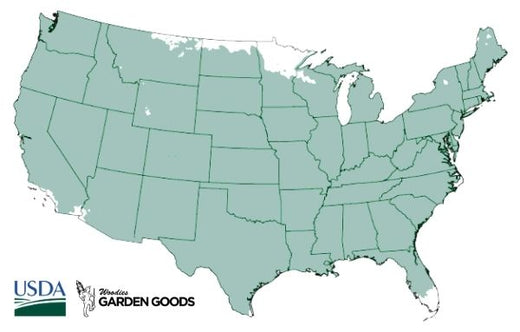
| Hardiness Zone: | 4-9 |
|---|---|
| Mature Height: | 6 to 8 inches |
| Mature Width: | 1 to 1.5 feet |
| Classification: | Perennial Groundcover |
| Sunlight: | Part sun to full shade |
| Habit: | Spreading |
| Spacing: | Plant 16" on center when planting as a ground-cover. |
| Flower Color: | White |
| Flowering Season: | Late Spring |
| Foliage: | Green |
| Soil Condition: | Average |
| Water Requirements: | Water well until established |
| Uses: | Extremely attractive when used as a ground cover in the mixed shade border, mass planting. deer resistant |
How to Care for Sweet Woodruff
Be sure to read our planting instructions to ensure healthy and happy Sweet Woodruff Plants for years to come!
How do I Plant Sweet Woodruff Plants?
To plant Sweet Woodruff (Galium odoratum), choose a location with partial to full shade and moist, well-drained soil rich in organic matter. Begin by loosening the soil and incorporating compost or leaf mold to improve structure and moisture retention. Space plants about 12 to 18 inches apart to allow for their slow but steady spread by rhizomes. Dig holes just deep enough to accommodate the root system, position each plant at the same depth it was growing in its container, backfill with soil, and water thoroughly to settle the roots. After planting, apply a light layer of mulch to retain soil moisture and suppress weeds, especially during the establishment period. Keep the soil consistently moist but not soggy as the plants take root, particularly during the first growing season. Sweet Woodruff is an excellent choice for planting under trees, along shady walkways, or in naturalized woodland gardens, where it will gradually form a soft, aromatic carpet of foliage and white spring blooms. With the right conditions and a bit of care, it quickly becomes a reliable, low-maintenance solution for shady groundcover needs.
How do I water Sweet Woodruff Plants?
To plant Sweet Woodruff (Galium odoratum), select a site with partial to full shade and rich, moist, well-draining soil—ideal for mimicking its native woodland habitat. Begin by loosening the soil and amending it with compost or leaf mold to improve fertility and drainage. Dig a hole just large enough for the plant's root system, place the plant at the same depth it was growing in its pot, and gently backfill with soil. Space each plant 12 to 18 inches apart to allow room for spreading, and water thoroughly after planting to help establish strong roots. Once in the ground, apply a thin layer of mulch around the base of each Sweet Woodruff plant to conserve moisture, suppress weeds, and maintain cool soil temperatures. Keep the soil evenly moist during the first growing season, especially during dry periods, to support healthy growth and establishment. Sweet Woodruff makes an excellent groundcover for shady gardens, beneath deciduous trees, or along woodland paths, where it forms a fragrant, mat-like carpet of green foliage and delicate white flowers. With the right care and site selection, this low-maintenance perennial will thrive and gradually naturalize in shaded areas.
How do I Fertilize Sweet Woodruff Plants?
Fertilizing Sweet Woodruff (Galium odoratum) is a simple process that helps support healthy foliage and flowering, especially during the plant’s early establishment. In spring, apply a light dose of balanced, slow-release fertilizer—such as a 10-10-10 blend—or work in organic compost around the base of the plant to enrich the soil naturally. Avoid heavy fertilization, as Sweet Woodruff prefers humus-rich but not overly nutrient-dense soil, and too much fertilizer can lead to excessive leaf growth at the expense of its delicate white blooms. Once established, Sweet Woodruff typically requires little to no fertilization, especially if grown in well-prepared soil rich in organic matter. An annual top-dressing of compost or leaf mold in early spring is usually sufficient to maintain vigor and promote steady spreading. This low-maintenance plant thrives in woodland gardens, shaded borders, and beneath trees, where it benefits from natural leaf litter and decaying organic material. By using gentle, organic feeding methods, gardeners can keep their Sweet Woodruff plants healthy, fragrant, and blooming year after year without overstimulating growth.

How and When should I prune Sweet Woodruff Plants?
Pruning Sweet Woodruff (Galium odoratum) is minimal but beneficial for keeping the plant looking neat and encouraging fresh growth. The best time to prune is immediately after the plant finishes blooming in late spring or early summer. Trim back spent flower stems and any leggy or overgrown areas using clean garden shears. This post-bloom pruning helps maintain a tidy appearance, stimulates denser foliage, and may encourage a light second bloom later in the season. Pruning also prevents the plant from self-seeding excessively if you're looking to control its spread. In late fall or early spring, you can perform a light cleanup by removing any dead or winter-damaged foliage to make way for new growth. Sweet Woodruff spreads by rhizomes and can become vigorous in optimal conditions, so occasional thinning may be necessary to prevent it from overtaking nearby plants. Whether used as a shady groundcover, underplanting for trees, or in woodland borders, regular but gentle pruning keeps Sweet Woodruff lush, fragrant, and manageable, enhancing its performance and beauty in the landscape.













